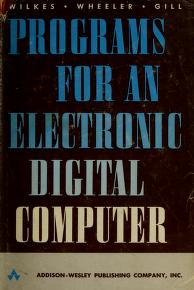Loading AI tools
First book on computer programming (1951) From Wikipedia, the free encyclopedia
The Preparation of Programs for an Electronic Digital Computer (sometimes called WWG, after its authors' initials)[1] was the first book on computer programming.[2] Published in 1951, it was written by Maurice Wilkes, David Wheeler, and Stanley Gill of Cambridge University. The book was based on the authors' experiences constructing and using EDSAC, one of the first practical computers in the world.
 The cover of the second edition, 1957 | |
| Author | Maurice Wilkes David Wheeler Stanley Gill |
|---|---|
| Language | English |
| Subject | Computer programming |
| Publisher | Addison-Wesley |
Publication date | 1951 |
| Publication place | United States |
| OCLC | 475783493 |
It was the first book to describe a number of important concepts in programming, including:
Much of the book is dedicated to explaining the library. This consisted of eighty-eight subroutines implementing mathematical operations like the calculation of trigonometric functions and arithmetic operations on complex numbers.[5] The library was a physical collection stored in a filing cabinet containing punched paper tape encoding the subroutines. This included a "library catalog" describing how a programmer could use each subroutine; today this is called API documentation.[3]

This chapter extensively investigates "proofreading" and location of the mistakes in the programs. It also advises against frequent refactoring as it introduces more mistakes as programmer tries to improve the program.
Includes examples of calculations of e-sinx formula and definite integral, integration of ordinary differential equitation, and evaluation of the Fourier transform by using EDSAC programs.
discusses an assembling (compiling) and interpretation of a program, it also discusses motivation behind "floating addresses" which are, in modern terms, variable references (akin to C++ variable references) which are replaced by compiler by a real memory addresses on the fly every time the subroutine is invoked.
This part contains mostly specification on the EDSAC's standard library's subroutines. Among included are subroutines for floating-point, complex numbers, debugging, exponential calculations, integration, differential arithmetic equations, logarithms, quadrature, and trigonometric subroutines.
The 1951 book was a mass-printed version of a report titled Report on the Preparation of Programmes for the EDSAC and the Use of the Library of Subroutines written in September 1950 for private circulation and distributed to no more than 100 people. Though written in England, the book was published by Addison-Wesley in the United States.[6][7][8]
At the time WWG was published there were very few digital computers in the world. EDSAC, on which the book was based, was the first computer in the world to provide a practical computing service for researchers.[1] Demand for the book was so limited initially that it took six years to sell out the first edition.[6] As computers became more common in the 1950s, the book became the standard textbook on programming for a time.[3] The second edition was printed in 1957.[6] By that time, technology had advanced to the point that WWG was somewhat outdated.[9][10]
Though WWG was the first published, book-length treatment of computer programming, it was not the first writing on the topic. The subject of programming had been pioneered by Ada Lovelace more than a century prior. It had also been written about more recently by John von Neumann, whose EDVAC Report of 1945 initially inspired Wilkes to create EDSAC.[1]
Seamless Wikipedia browsing. On steroids.
Every time you click a link to Wikipedia, Wiktionary or Wikiquote in your browser's search results, it will show the modern Wikiwand interface.
Wikiwand extension is a five stars, simple, with minimum permission required to keep your browsing private, safe and transparent.